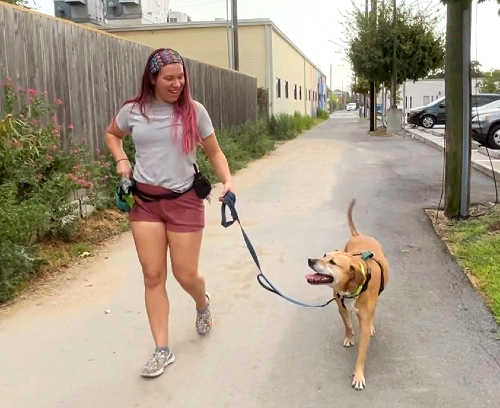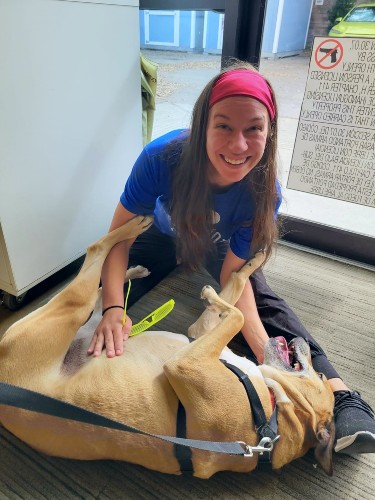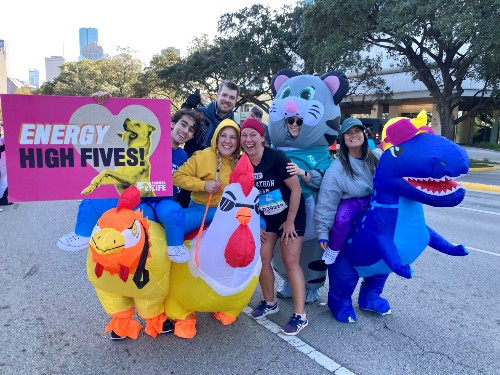
“My first memories following my accident were at TIRR Memorial Hermann,” said Alese. “I remember seeing my brother and sister at TIRR Memorial Hermann. My coworkers were also there from the beginning—they created a schedule to visit me as well as to take care of my dogs while I was in the hospital, and that meant a lot to me.”
Alese works at Friends For Life, an animal rescue shelter. In her role, she has numerous responsibilities including managing animal adoptions, outreach programs and general operations of the facility. Her work is very meaningful to her and she worked hard at rehabilitation so that she could return to the career she enjoys.
“When I first met Alese I suspected she would make excellent progress solely due to her motivation and determination,” said her inpatient speech-language pathologist Annabelle Cole, MS, CCC-SLP. “Although Alese was having difficulty remembering recent events, her loved one's names, and the name of the organization she works for, she absolutely lit up when describing the work she does at Friends For Life animal shelter. I quickly knew it would be wise to use returning to work as a motivating factor during therapy sessions. Alese had difficulty finding the right words she wanted to say, so we worked on utilizing various strategies to help with her word-finding deficit. Alese additionally had difficulty with thought organization and sequencing steps.”

Annabelle said, “Alese would tell me ‘I don't have to think so hard when I'm talking about the dogs.’ Alese made exceptional progress during her stay at TIRR.”
During inpatient physical therapy, Alese had the opportunity to work with therapy dogs.
“Thursday visits from our therapy dogs provided her with motivation and some much needed emotional support,” said her inpatient physical therapist Louis Nicolosi, PT, DPT, NCS. “We described activities in terms of how she would need to perform at work such as getting on the ground to work with a dog, or needing to improve balance so she could handle an energetic puppy on a leash."
Louis and Alese also focused on walking practice at high intensities with decreasing support from external support like walkers and from therapists. “We utilized heart-rate monitors to provide us with real-time feedback and set a target rate of 70-85% of her heart rate max with the goal of maintaining those levels for longer periods of time and distances each day,” said Louis. “Additionally, each week we re-assessed her balance and walking through standardized measures and provided Alese with a PT report card to show her progress.”
“Alese came to TIRR Memorial Hermann less than three weeks after a traumatic brain injury,” said Dr. Lindsey Harik, a clinical neuropsychologist at TIRR Memorial Hermann. “She was clearing from a post-traumatic confusional state at an impressive rate during her time with us. She was unique in that, because she was doing so well cognitively, she began experiencing a very appropriate psychological reaction to her circumstance while still at TIRR Memorial Hermann. She was asking big, life-altering questions and was developing awareness of what her rehabilitation journey would entail well after she discharged home. Understandably, she experienced periods of low mood, worry and even despair. I knew she would do well because of how she reflected on these periods of low mood; she was able to see herself as a survivor, rather than a victim, of brain injury. That active stance really set her up for success. Because she saw herself as someone who had agency over her situation, we were able to discuss and prepare for future hurdles so that when they occurred, she understood that this is a part of getting better rather than seeing a hurdle as a setback.”
Alese was an inpatient at TIRR Memorial Hermann for three weeks.
“When I left inpatient care at TIRR Memorial Hermann, I was primarily in a wheelchair but could walk a few feet with assistance,” said Alese.
She transitioned to TIRR Memorial Hermann Outpatient Rehabilitation – Kirby Glen Center for six weeks of therapy.
“In outpatient therapy I did lots of standing up, and started walking further,” said Alese. “I steadily improved my speed and distance. Once I was able to run six feet, I cried with happiness because I felt so accomplished! I walk dogs a lot, so I needed to regain my strength and stamina in order to do that. I was able to improve those abilities during outpatient therapy.”
Alese also participated in TIRR Memorial Hermann’s Challenge Program, which provides a comprehensive range of services to help brain injury and stroke survivors maximize their potential. Specialized services focus on community integration skills critical for the transition to independent living, school, work or volunteer activities following brain injury.
For Alese, clinical staff customized the program to prepare her to return to the career she loves.
“Alese rehearsed conference presentations and tours of the animal shelter she works at, to target the cognitive-linguistic skills she would need to return to work,” said Bethany Brenneman, MS, CCC-SLP, a speech-language pathologist with the Challenge Program. “All the skills she targeted in therapy culminated in providing an actual tour of Friends For Life to a group of peers from the Challenge Program.”
Her social worker, Elizabeth Reeves, LCSW, with the Challenge Program, created a gradual “return to work” schedule for her so that Alese could slowly begin her career again.
“She started out working a few hours per week and increased the number of hours she worked weekly,” said Elizabeth. “We practiced simulating the activities she would do at her job, such as working on a computer.”
After eight weeks, Alese discharged from the Challenge Program. However, she was able to invite other Challenge patients to Friends For Life to assist in the facility through a program called Work Project.

“Challenge patients were able to go to Friends For Life and help them organize supplies and build warming houses for stray cats,” said Elizabeth. “It was a full-circle moment where a former Challenge patient was able to provide an activity for current Challenge patients.”
As Alese continued to improve, she created a new goal for herself; she wanted to complete a half marathon. “I grew so much at TIRR Memorial Hermann—I figured if I could re-learn how to read, stand and walk, I can figure out how to complete the Houston half-marathon,” she said.
So, she signed up and ran on behalf of her beloved Friends For Life organization.
“To train, I started out walking around the block with my husband,” said Alese. “Then, I did that faster. I did it while walking my dogs. It was slow progress, but I used a training app and just took things step by step.”
In January 2024, one year after her accident, she completed the half marathon with her friends and family cheering her on.
“Although I completed that half marathon, I am honestly more proud of the work I did at TIRR Memorial Hermann.”
Alese has also returned to work full time, spending her days surrounded by the animals she cares for and the coworkers that have cheered her on from the beginning.

Nationally Ranked Rehabilitation
For the 35th consecutive year, TIRR Memorial Hermann is recognized as the best rehabilitation hospital in Texas and No. 2 in the nation according to U.S. News and World Report's "Best Rehabilitation Hospitals" in America.
Learn MoreContact Us
If you have questions or are looking for more information, please complete the form below and we will contact you.